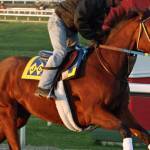Multiple Causes for Muscle Problems in the Exercising Horse

The term “tying-up” has been applied to describe horses that develop firm, hard gluteal and lumbar muscles and the inability to move the hindquarters after exercise. Other terms for this syndrome include azoturia, Monday morning disease, exertional rhabdomyolysis, and chronic intermittent rhabdomyolysis.
Years ago, all horses with muscle pain and cramping after exercise were thought to have the same disease. It is now known, however, that a number of different conditions can lead to similar types of severe muscle cramping. By applying clinical protocols that include muscle biopsies and exercise testing, a number of specific disorders have been identified.
Signs of exertional rhabdomyolysis can range in severity from mild stiffness following exercise to recumbency. During exercise, horses develop a short, stiff stride, sweat profusely, and have an elevated respiratory rate. Upon stopping, horses are reluctant to move, males frequently posture as if to urinate, and in severe cases myoglobinuria may be apparent. Physical examination reveals painful muscle cramps, especially in the gluteal area. Scintigraphic evaluation of horses with rhabdomyolysis following exercise shows symmetrical damage to the gluteal, semitendinosus, and semimembranosus muscles. Some horses may be extremely painful, which could be confused with colic. Muscle pain usually persists for several hours. Endurance horses often show other signs of exhaustion including a rapid heart rate, dehydration, hyperthermia, synchronous diaphragmatic flutter, and collapse.
A diagnosis of exertional rhabdomyolysis is made on the basis of a history of muscle cramping and stiffness following exercise and moderate to marked elevations in serum myoglobin, creatine kinase (CK), lactate dehydrogenase (LDH), and aspartate aminotransferase (AST). These serum proteins are listed in the order of their rate of increase in the blood and in reverse of their rate of clearance from serum. Muscle enzymes can also guide when a horse can go back into training, when they return to normal levels.
The objective of treatment is to relieve anxiety and muscle pain, correct fluid and acid base deficits, and prevent renal compromise. The hydration status of horses with myoglobinuria should be assessed immediately. Oral and/or intravenous fluid therapy is a first-order priority in dehydrated horses prior to the administration of nonsteroidal anti-inflammatory drugs (NSAID).
Acepromazine, an alpha-adrenergic antagonist, is helpful in relieving anxiety and may increase muscle blood flow. Its use is contraindicated in dehydrated horses. In extremely painful horses, detomidine provides better sedation and analgesia. Nonsteroidal anti-inflammatory drugs at relatively high doses provide pain relief. Intravenous dimethyl sulfoxide (as a < 20% solution) and corticosteroid administration have also been advocated in the acute stage. Muscle relaxants such as methocarbamol seem to produce variable results.
Rest with hand-walking once the initial stiffness has abated is of prime importance. At this time the diet should be changed to good-quality hay with little grain supplementation. The amount of rest a horse should receive is controversial. Horses with recurrent exertional rhabdomyolysis appear to benefit from an early return to a regular exercise schedule. Horses that appear to have damaged their muscles from overexertion may benefit from a longer rest period with regular access to a paddock. Training should be resumed gradually and a regular exercise schedule, which will match the degree of exertion to the horses underlying state of training, should be established. Endurance horses should be encouraged to drink electrolyte-supplemented water during an endurance ride and should be monitored particularly closely during hot, humid conditions.
The most common cause of exertional rhabdomyolysis is exercise that exceeds the horse’s underlying state of training. This includes both exercise at speed as well as endurance riding. Tears in the junctions between intracellular myofilaments (Z lines) are a common cause of post-exercise muscle soreness in humans. The incidence of muscle stiffness and exertional rhabdomyolysis has been observed to increase during an outbreak of respiratory disease. Both equine herpes virus 1 and equine influenza virus have been implicated as causative agents. Mild muscle stiffness with concurrent viral infections is likely the result of the release of endogenous pyrogens.
More severe rhabdomyolysis may be due to exertion during a concurrent systemic infection and/or viral replication in muscle tissue. Since the inciting cause is usually temporary, most horses respond to rest and a gradual increase in training. This may also account for the myriad of treatments that claim they will cure tying-up in horses.
Skeletal muscle shows remarkable ability to regenerate following injury, and complete repair of muscle tissue is possible within four to eight weeks after an episode.








